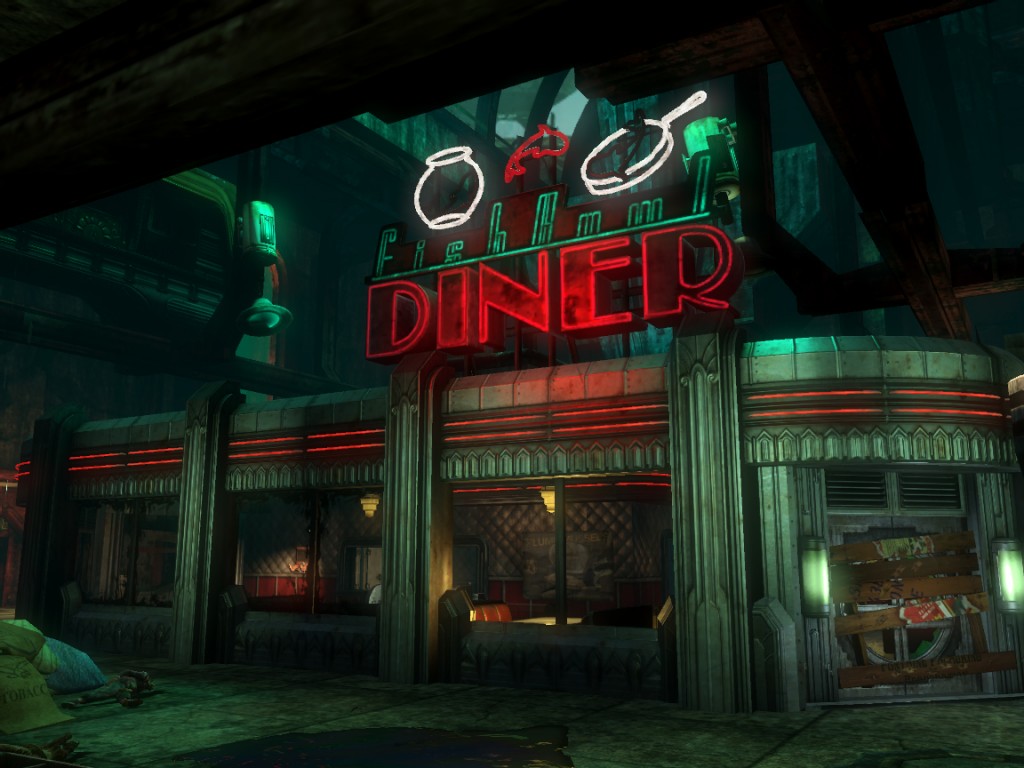“And now you come swanning into my neighbourhood looking for me? Wrong turn, tin daddy.”

This first instalment of Groping The Map will be presented in multiple parts, running over the next several weeks:
- Introduction.
- Annotated Walkthrough, 1: Diner and Downtown.
- Annotated Walkthrough, 2: Market.
- Annotated Walkthrough, 3: Sinclair Deluxe.
- Combat in The Drop: Encounter Design.
- Life Below The Tracks: Aesthetics and Environmental Design.
- Conclusion and References.
Introduction:
As Subject Delta you enter Pauper’s Drop a monster, by the time you leave your actions have either confirmed or confounded that expectation. As a player you enter the fourth level of BioShock 2 with a vague sense of what this game is about and leave having experienced your first taste of the themes and subtext at work in the bowels of Rapture. Along the way you gain a greater understanding of how this game differs from the original BioShock.
Thematically Pauper’s Drop is a monument to the human spirit, it is rife with signs of the struggle of it’s populace to retain dignity and humanity in the face of poverty, oppression and mutation. It’s unsurprising that the character the player is there to find is called Grace Holloway. The concept of grace under adversity sums up the attitude of the denizens of what is, possibly with warped affection, referred to as The Drop.

Pauper’s Drop is not an intended stop on your journey to Fontaine Futuristics, however the visit itself serves to provide a greater context for your actions and begins to flesh out the events that led to the creation of your unique bond with Eleanor Lamb. You have already been introduced to her ‘biological’ mother and in subsequent levels will meet two of the men who could be considered her father. For now you must face the woman to whom Eleanor was a beloved daughter. A foster mother who failed in her role as guardian and mentor and who sees your destruction as her atonement; an act that may finally allow her to assuage her own guilt.
Mechanically Pauper’s Drop could be consider the first ‘full’ level of BioShock 2. By the time you reach here, you will have been introduced to nearly all the core mechanics and can be guaranteed to have access to the three primary plasmids: Electro Bolt, Incinerate and Telekenisis. In terms of weaponry you will have found the Drill, Rivet Gun, and Machine Gun (Along with the Hack Tool) and will be provided with a Shotgun in the early stages of the level.
This is the last level in which the player’s starting tool-set can be guaranteed and as such the majority of the encounters within this level have been designed to make good use of these tools. The early areas of the The Drop are focused on mid-range combat to allow the player to make use of the Rivet Gun and Machine Gun, along with a variety of clutter that can be wielded with Telekenisis. Later having finally gained access to the Sinclair Deluxe the environment changes to become more focused on close quarters combat encouraging the use of the recently acquired Shotgun and highlighting it’s potency at point blank range.
Structurally there is a gradual increase in complexity as more areas become accessible. What at first appears to be a fairly standard hub and spoke layout opens up upon entering the Clinic to include a network of back rooms, rooftops and connecting walkways. A similar expansion can be seen inside the Sinclair Deluxe where a location that feels instantly familiar, and recalls other locations in Rapture, becomes an interconnected maze of abandoned rooms, crumbling internal walls and collapsed ceilings.
There are a number of repeated layout tropes used throughout Pauper’s Drop, some of which can also be seen in the subsequent level Siren Alley. A similarity which might be due to the original layout of these spaces that had both areas existing inside a single level. The most common connecting feature of these two levels is the use of vertical space. The third dimension is put to good use to grant access to otherwise blocked locations, or to provide a height advantage during combat.
Aesthetically there is a distinct ‘Film Noir’ vibe to The Drop, diners, jazz clubs and private detectives, this is the seedy underbelly of Rapture and everything from the makeshift nature of the environments to the vaulting utilitarian architecture reinforces that. Bathed in sea green it feels like the entire ocean above is weighting down on The Drop, the only elements of humanity picked out with sharp contrast by neon reds, and fiery oranges.
Pauper’s Drop is something new for Rapture, it is the home of the dispossessed and the discarded, the unwashed and the unwanted. There have always been cracks in the glittering facade of Rapture but nowhere have they been more apparent that below the lines of the Atlantic Express.
One reply on “Groping The Map: Pauper’s Drop, Part 1.”
[…] in the first game would rather have kept out of sight and out of mind. Justin Keverne’s fantastic multi-part close reading of one of these spaces, Pauper’s Drop, is a great exploration of what makes these spaces tick. […]